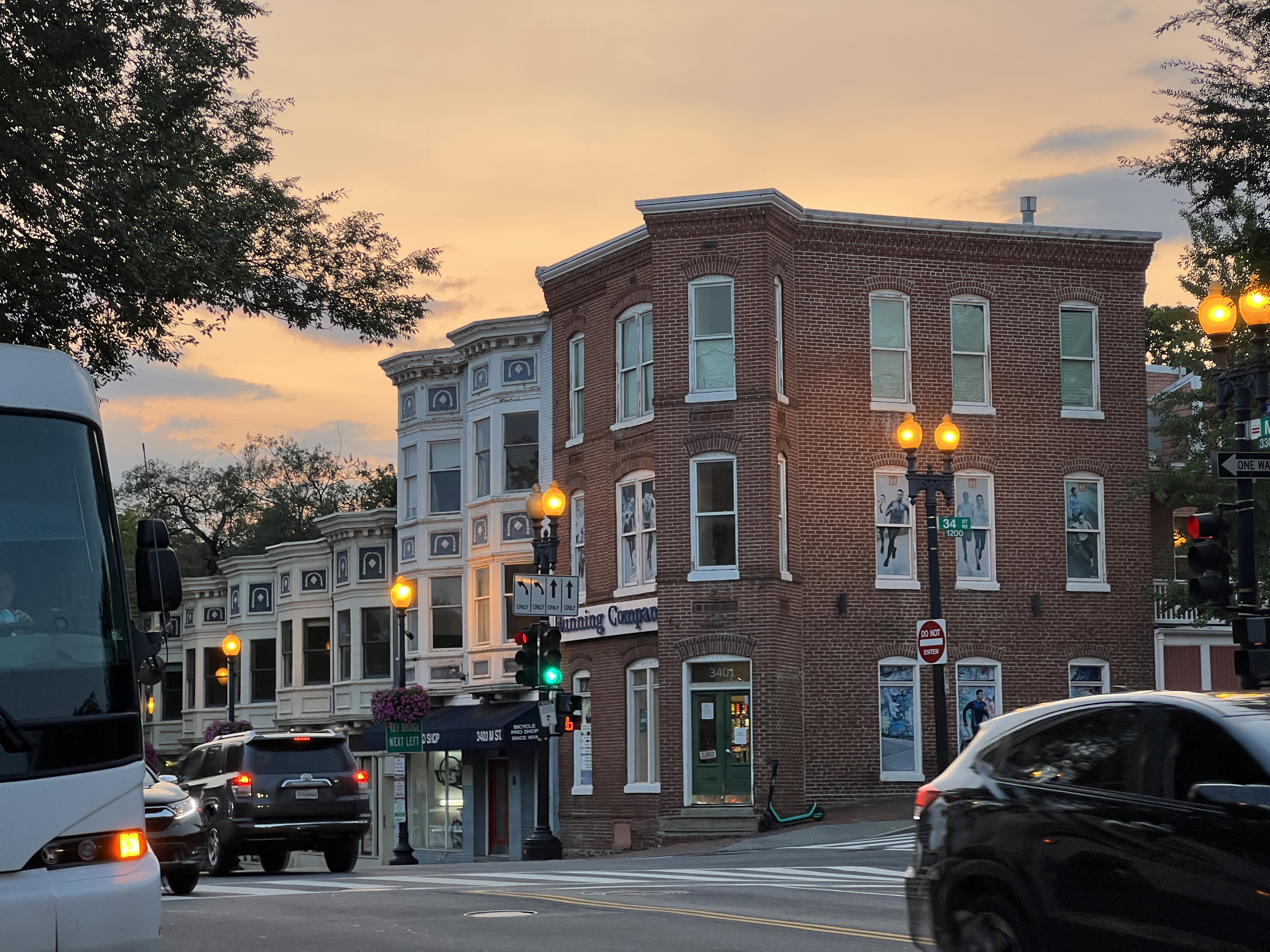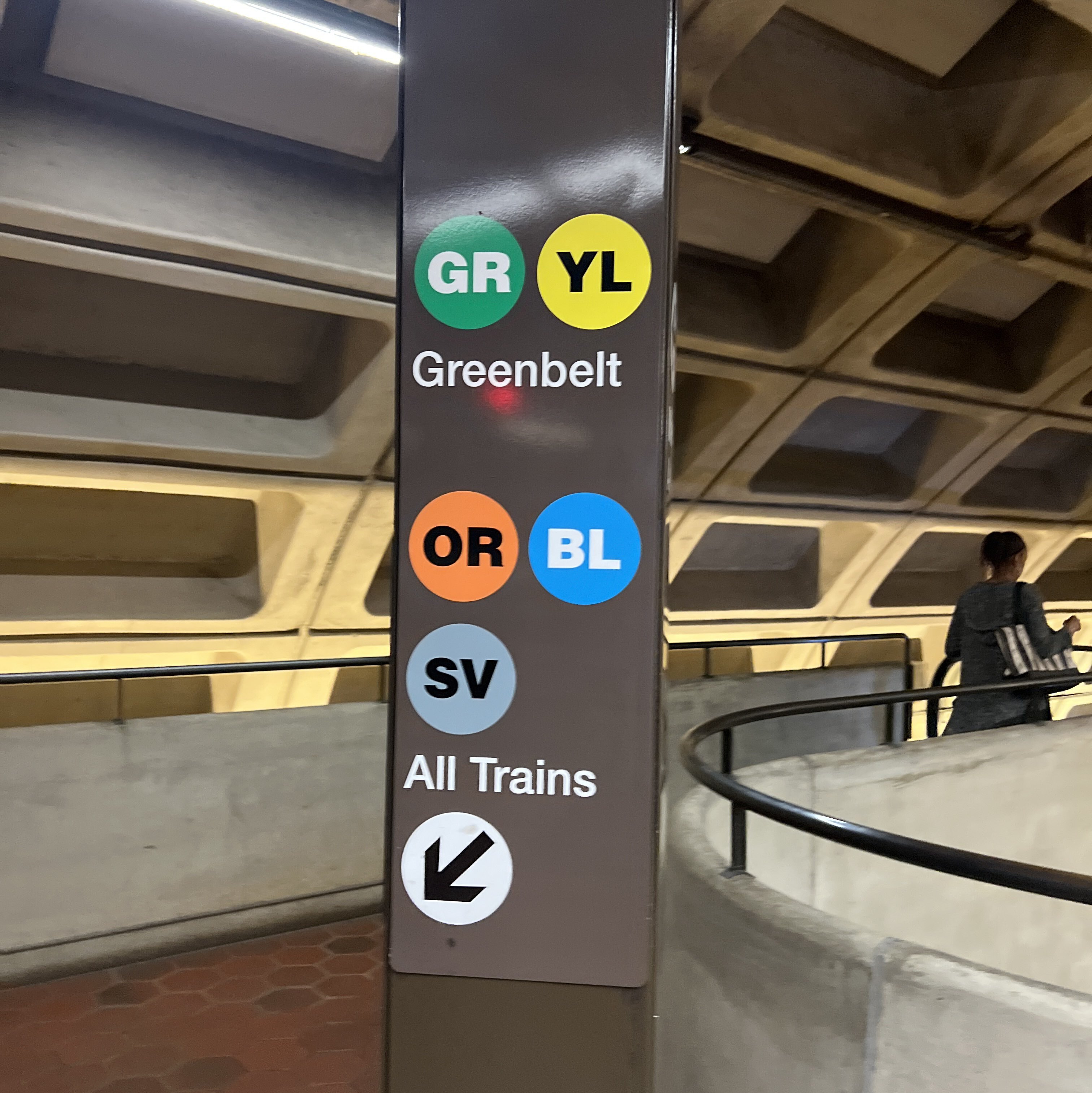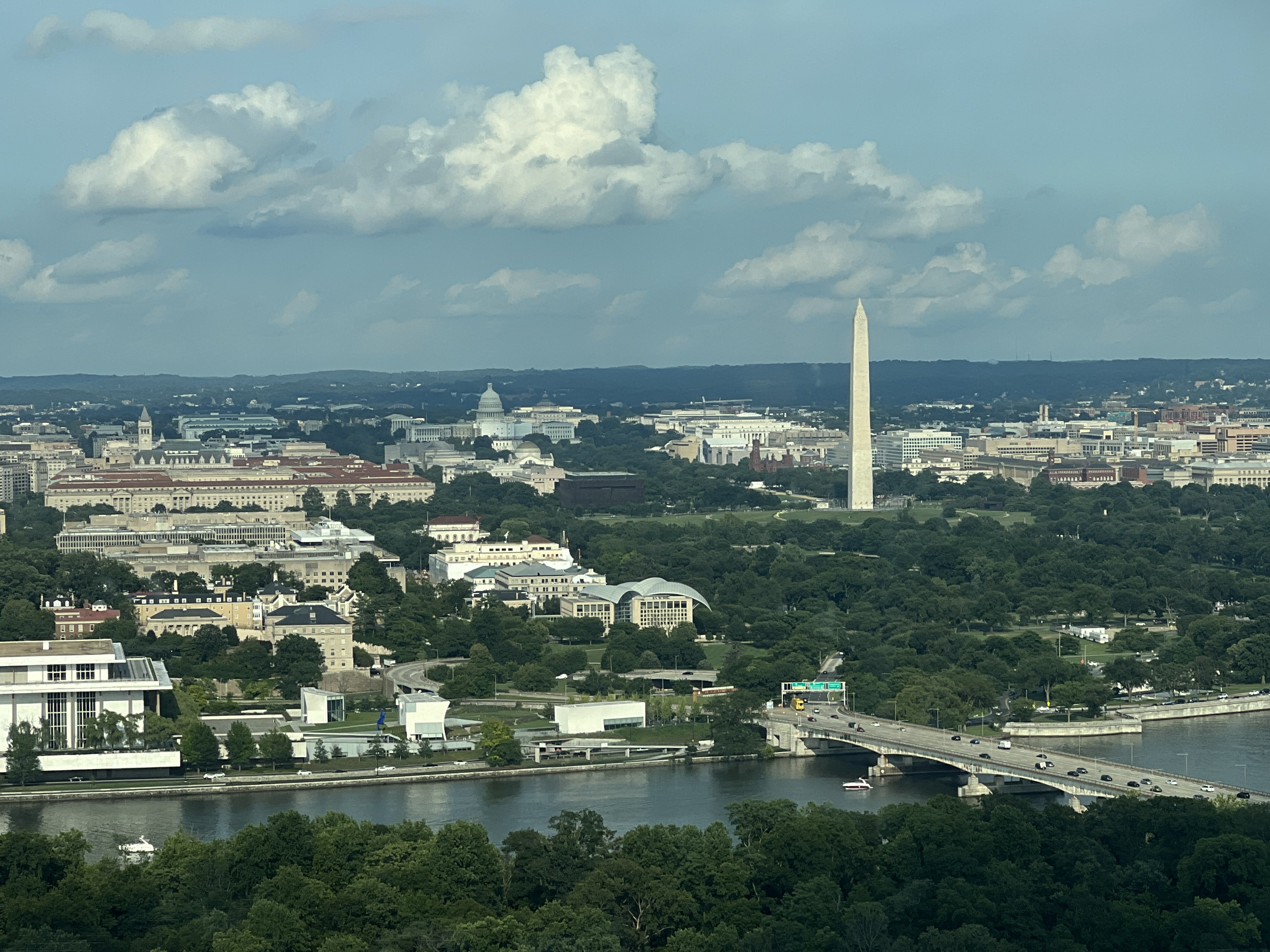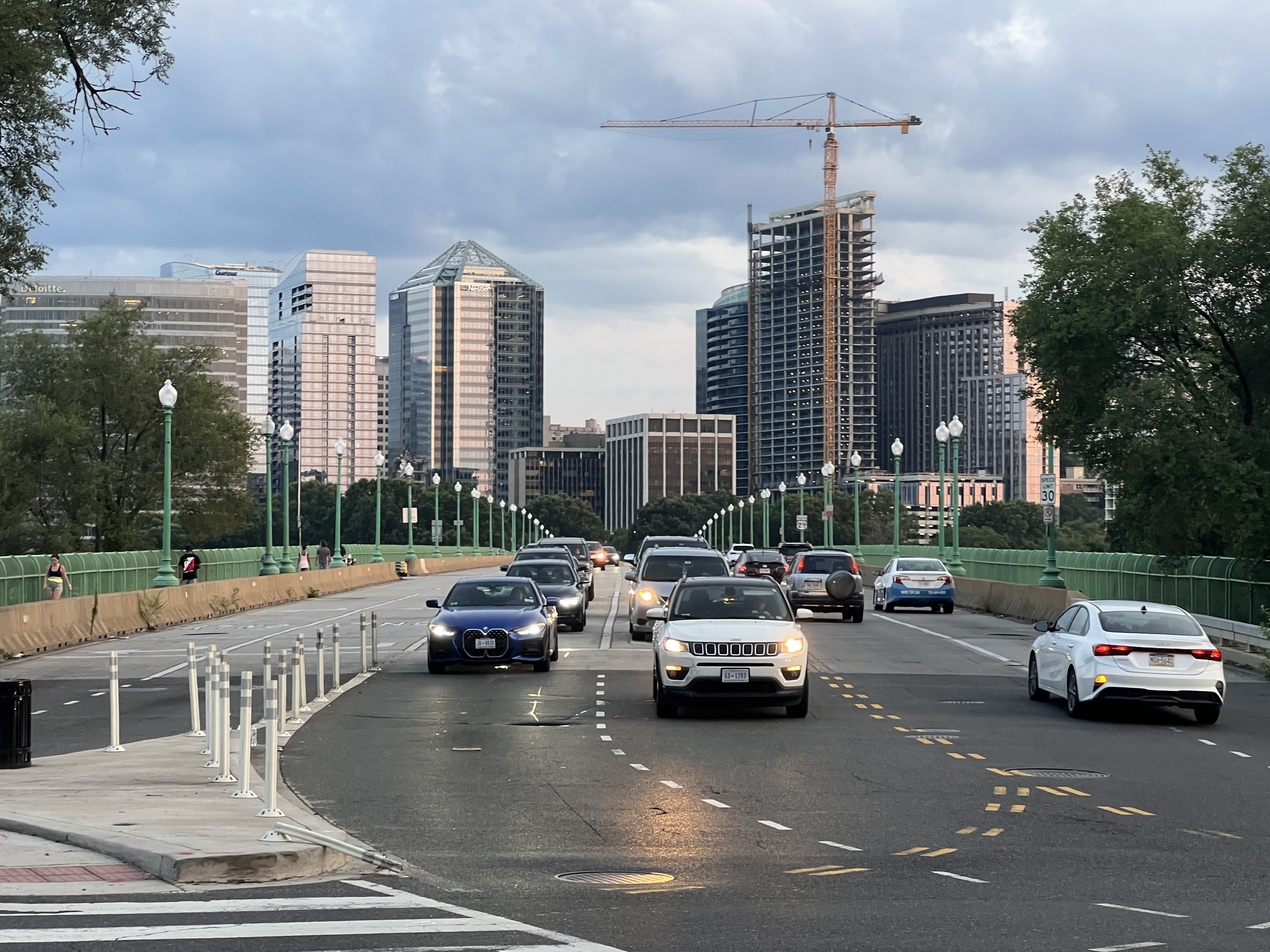Why don't you go back?
Washington, Douglas Commonwealth - A City With Good Bones
A vibrant metropolis with a diverse array of landmarks, museums, and locales, Washington D.C. has the potential to become one of America's--perhaps the world's--greatest cities. But it has work to do.
July 16, 2023: 7:00 PM, M Street & 33rd Street, Georgetown:
I arrive on a DC MetroBus across the Potomac from Arlington, whose first stop in Georgetown put me at the center of a corridor I can only describe as idyllic, perhaps even picturesque. Beautiful evening hues from the sun shine on the historic two to three story buildings, varying from chessboard black and white to red-crimson brick. I'm looking for a place to eat with a friend, and while we're Googling potential locations, randomly wandering about while following the flow of pedestrians, we immediately stumble upon an Austrian restaurant in the midst of a scenic alley just down the sidewalk. As a born-and-raised New York City resident, I've seen my fair share of fancy restaurants. Upon walking in, I'm greeted with not just the fresh air of the AC, but an atmosphere of people and food that whispers a subtle form of classy. As if Park Slope were ripped from its roots and placed on top of the Potomac, we enjoyed an upscale, delicious, and filling meal for not more than 30 dollars each (before tips) while watching people in suits and dresses chit-chat about finance and politics over glasses of chardonnay. We walk down M street looking for dessert, and once again, we find an excellent ice cream shop not three blocks away in the midst of a storefront adjacent to multi-family townhouses. Spoon and pint of ice cream in hand, we head to the Georgetown University campus. It is very apparent that the feel of this neighborhood, both in its structure and its community, was at least partially due to its proximity to one of the top 20 best universities in the nation. Young college students and upper middle class professionals, both alike in their lifestyles, populate the area with their consumerist predilections. (one of the last businesses on the street before the campus was a Starbucks.)

In the midst of even the wealthy urban oasis, however, were some glaring holes that to a larger degree represent the flaws of Washington, D.C. as a whole. Attempting to enter the campus, we are greeted by two major arterial roads, both of which have the effect of creating an uneasy presence on M Street, which is renamed Canal Road upon campus entry. Cars sputtering along F. Scott Key Bridge and Whitehurst Freeway abruptly interrupt the previously comfy feel of the street and bring pedestrians into a direct conflict with cars at both the Key Bridge and the freeway intersection. Though pedestrians get their own separate walkway on Key Bridge, that comfort too gets an abrupt end if they so much as dare try to cross M Street. It is now 8 PM, and it was time to return to Union Station. There is no metro rail service in Georgetown to Arlington or downtown D.C., so we must take the bus back, another glaring limitation of the urban makeup of the region. Once again, we are rather miffed by the still even more lackluster transit, having to book it for a bus that now runs only every half hour. Being a Sunday evening isn't the best excuse, as people were still in fact clamoring for donuts on the bakery across from the bus stop. I'm sure they would have liked to not wait 30 minutes for a bus back downtown as well.
From terrible bus traffic back to Union--which wasn't helped by the bus stopping every block--to the universally terrible experience of riding Amtrak, it seemed that a perfect urban evening quickly devolved into a state of special American-brand madness.
My Review
If someone had to ask me what D.C. was like from the 8 hours I spent there (admittedly not a long time), I would have to say it is a body with obvious wounds and cuts, but one with good bones underneath. This is a much better prognosis than the ones I would have to give to the other eastern seaboard cities I've visited in my time. Because my tale at Georgetown and Union slid into scathing grimness so quickly, let's begin with what I really liked about D.C. as a whole.
A Metro Well Done
My absolute favorite aspect of D.C. was its Metro. Built in the 70s with help from the 1969 National Capital Transportation Act, which allocated so much to the system that federal funds became two-thirds of its investment, it is (with some flaws) an incredibly well-organized, clean, consistent, and reliable system. Red, Orange, Yellow, Green, Blue, and Silver lines work on a fully inter-compatible network, something even New York or Boston cannot do with their century of development. New York's IND/BMT vs. IRT and Boston's completely incompatible Red/Green/Blue/Orange/Silver lines pale in comparison to the spaghetti of intersecting, interlining, inter-compatible trains of D.C.'s system.

The stations are all built in nearly identical fashion, with tiling, ceiling, floor, and escalator patterns completely indistinguishable from one another. Novelty snobs may regard this as a creative failure, but there is plenty of art to go around in this city. I'd personally save the creativity to the museums, and reserve economic prudence, and effective, consistent station design to the subways. If nothing else, this shows the true power of top-down government funded transit when done right. The brutalist style (consistent with a lot of D.C.'s most protected federal facilities) and the lengthy escalator rides to stations (reminiscent of Moscow, Prague, and the NYC 2nd Avenue Subway) are certainly not in my taste to be sure, but the unbeatable reliability more than makes up for these things. In my over ten subway rides in the day, not one of them required more than an eight-minute wait, and most of them were under five minutes. This was on a Sunday! Well done, D.C. (8.5/10, could still be more frequent, and the escalator egress was a chore)
Development to be Developed

Made from a classic style of stone and brick, the buildings of Washington certainly evoke a homely feeling, similar to what one might see in Barcelona or Paris. However, something did in fact feel off. Besides the White House and Washington Monument, the skyline of D.C. is completely barren, as if a giant sheet slid through the city 200 feet in the sky and vaporized anything above it. I got this harrowing view from nearby Rosslyn, Virginia. Dotted with skyscrapers, including the illustrious (and free) View of DC, where I stood, one can easily witness the height disparity between these two cities. Much like Paris's historic downtown and her business park cousin, La Defense, these city pairs show the unintended consequences of rigid development policy. It was indeed the Height of Buildings Acts of 1899 and 1910 that limited D.C. building heights eventually to only around the width of the streets that they're on. Rising concerns about skyscrapers and their steel frames potentially collapsing or causing uncontrollable fires was ultimately what led to these Acts passing, however it is clear to us as modern-day Americans that these concerns are very obviously frivolous. While the excuses may change, the general American fear of high-rises and skyscrapers never left the urban discourse. Be it gentrification from the liberals, or inversely, unwanted racial integration from the right, or corporate monopoly control of the urban landscape from the socialists, fears come out from every square inch of the political spectrum to bully the skyscraper out of existence. As many people more intelligent than me have already pointed out numerous times, not only does densification and tall urban construction help to promote greater racial diversity within developments, as greater affordability through higher supply attracts a more mixed ethnic palette of working class residents, it is also generally more economically viable and sustainable to build high-rises than the more fanboy-ed townhouse or rowhouse.

While I am by no means saying erase rowhouses, I am saying that high-rises do a better job at housing more people at lower costs of construction, maintenance, and carbon per person. It would also help to mention that there is no ethical housing consumption under capitalism. Sorry to say it, but that realty company was just as glad to hold a monopoly over your cute rowhouse neighborhood when it was built in Park Slope as it is today over high-rises when they're being built in Long Island City. Erasing skyscrapers, then, does not inch us any closer to that glorious worker's paradise that we all deserve. In defending 150-foot height limits, many so called "urbanists", as Vishaan Chakrabarti points out in A Country of Cities, find an unlikely ally in NIMBYs rather than planners. Oftentimes, the same urges to defend the single-family detached (redlined) home from changes to "character of neighborhood" shine through once again in defending low-height urban buildings. To me, a NIMBY is a NIMBY is a NIMBY is a NIMBY, so unless you wish to consign yourself to this status, get in line to picket for floor-area ratio laws with me next time you're in D.C. Simply allowing taller buildings to be built does not erase any of the historic character that D.C. has absolutely built for itself, that I am not trying to go near, but it will instead allow city developers to address wherever possible the housing crisis that affects not only our capital city, but cities all over the U.S.A. Allowing for greater possibilities in development will provide a comfortable "missing middle" between the burgeoning skycrapers and the low stone/brick buildings separated merely by the Potomac. (6/10, the pretty buildings do still catch my mortal eye)
Street Design, a War on Pedestrians
Like in Georgetown, like in all other parts of D.C., and dare I say even the rest of America, the street is overwhelmingly designed to prioritize the flow of cars, and pedestrians are forced to take whatever is left. This resulted in numerous instances of the same classic American problems: either waiting too long at an intersection, or having an entire minute to cross the road; the lanes of cars on the road being too wide and too numerous (why does K Street need 3 lanes and an access road?), lack of any sort of speed mitigation at intersections or on the roads, and lack of shade cover at many of the city's streets.
We're going to cover each one.
Intersections whose light cycles last at least two minutes are an obvious indicator species of car-centric design. Traffic engineers care more about maximizing the throughput of cars than the time, safety, or comfort of pedestrians. As a result, if a pedestrian isn't able to make it to a street in time before the light ends, they will have to wait for a minute or more, often times in a road that is too wide to support a comfortable urban walking experience, which gets into my next point.
In D.C., when streets are over 150 feet wide, chances are it's not going to be because the street is filled with countless vendors selling shish-kebab, dumplings, and trinkets while pedestrians roam around freely. It's likely because 80% of the street will be devoted to cars, having at least two or three or more traffic lanes per direction. On streets with shops and local businesses, this can kill any chance of an economically successful street. This is what is known by Strong Towns author Charles Marrohn as a stroad, infrastructure that tries to do the work of providing a productive, fun, commercial space that a street would, and a thoroughfare for transit (mostly cars) that a road would. This creates the effect of making it impossible to drive through many of these stroads, and making it impossible to walk through and enjoy many of them.
Take Independence Avenue, for example. While not the most egregious stroad in D.C., it is certainly the most well known of them, having numerous museums such as the Smithsonian series, the Botanical Garden, and the Museum of the American Indian. Despite this, it is a combined seven lanes wide, has almost no tree cover in its most popular locations, and intersects with streets that are almost as wide, and take several minutes to cross; truly a stroad nightmare combination. Walking, no, merely existing on this road during the hot summer afternoon that we were here on was a challenge on its own. With no tree cover, and nothing but asphalt everywhere, good luck keeping cool, and no wonder the Smithsonian's ACs blew so hard. The climate control should not have to end when one leaves the museum buildings; there are ways to cool a street without Freon.
The museums themselves of course, were lovely. Seeing fighter jets, rocket ships, and race cars all in the same building in the Smithsonian Air and Space Museum was a sight to behold, even for an infamous car hater like myself. Too bad half of it was under construction at the time.
Walking further down Independence, things only got worse, as America's most attraction-studded street turned into a car hellscape. Capitol Hill became a literal highway obstacle course, forcing pedestrians and high speed drivers to intersect numerous times in order to get across. AND WHY ARE RIGHT TURNS ON RED ONLY ILLEGAL IN NEW YORK?? THIS SHOULD NOT BE A THING ANYWHERE IN THIS COUNTRY. From 3rd Street West to 1st Street East, it is nothing but Capitol Driveways and Washington Avenues wider than a family of elephants tearing its way through what should be an idyllic walk through the sights of the Capitol Building and Supreme Court. For a country that was bulldozed to support the car, having a capitol park built in such a manner is only fitting, I guess. (6/10, because many streets were still pleasant nonetheless, and because there are so many attractions to see despite their unfortunate placement)
Other Transit: Left to be Othered
Bus Service - From the very little that I experienced, not so great. The fact that many buses only run two per hour on evenings is a little disappointing. An acceptable level for intercity, it is certainly not for **intra**city travel.
Regional Rail - I didn't try it (sorry Marc)
Amtrak Service/Station - I have... a few issues with my Union Station experience here, as I imagine most people taking rail cross-country in the USA can attest.
-
Trains at this station alternate between diesel to the south and electrified to the north. Any through-running DC train must switch crews, locomotives, and dwell on-station for a half hour through the process.
-
Through-running is commonplace, and worsens the effects of crew and passenger fatigue, forcing crews to switch mid-trip and leaves trains crowded, making them harder to board and find seats in.
-
The spatial physics of Washington Union just plain does not work. Comparably annoying Moynihan Train Hall is wide, spacious, and provides ample space for passengers lining up to board regional trains down the long escalators. Cut back to Union, and hundreds are lining up against a door that is narrower and more poorly marked than the door to my college dorm room. People repeatedly find themselves lost due to poor markings (why does a train station need gates?????) and fights break out when passengers squeeze through the makeshift line into the meager door.
-
All of these three conditions combine to make Washington Union a notorious hotbed for delays. This is anecdotal, but another group of ours, having had to take an earlier train due to the younger students onboard, waited at Union for two and a half hours past the scheduled depart time. What did they do? Not much besides sit in a chair, of which there are plenty, no thanks to how infamously behind schedule trains are at this station. A late train just before us having only recently left, our Amtrak Northeast Regional 128 back to New York had to board at full capacity before even leaving D.C.
All in all, this lackluster aspect of D.C. transit may explain why many in the area struggle to switch from their cars. The Metro can only cover so much, and eventually, other forms of transit need to step up. (4/10, mediocre if not disappointing)
Final Thoughts
Though I was mostly harsh and scathing in my review, do not let this be unheard: I liked Washington. It, in the grand scheme of American cities, most of which I'd give a 3 overall, is actually an enjoyable place to be. It is one of the few cities in the USA as a New Yorker that I'd still be comfortable living in. The Metro is designed and planned well enough for me to use on a daily basis, the street network has a good fabric that can absolutely be improved over time with the right work, and there are LOTS of leisure options.
I often felt myself so comfortable with the layout and design of D.C. that I did not feel myself brush up against the gears of the city's system, an experience I often do feel in other, less transit oriented cities. It is comfortable enough for me to turn off my brain's scathing reviewer section, and just have fun.
While DC has a lot of wounds and scabs, it is a city with good bones.
I'll see you down the Atlantic some other time, my landmark-studded friend.